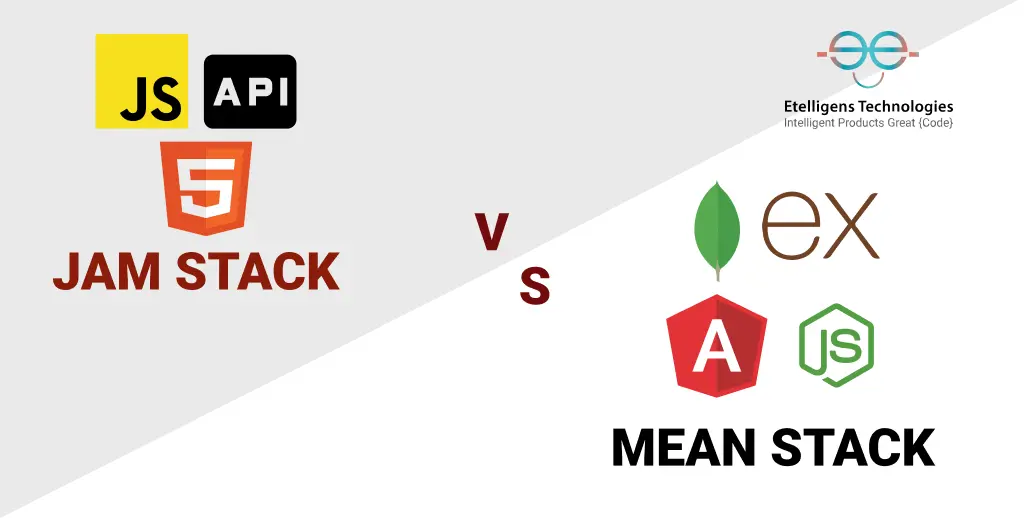In web or app development, using the right type of technological elements is very important to get the right kind of functionality. This depends on various factors that all constitute within tech stacks for client-side and server-side use, like:
- Development tools
- Programming languages
- Libraries
- Frameworks
- Programming approaches
The right combination ensures better scalability, functionality, and ease of use of the resulting products. For developers, selecting the right kind of technology stack for their project becomes one of the main priorities.
To note, all developers have their specific favorites as each stack comes with unique features and benefits. Two notable versions are the Jamstack and MEAN stack.
However, which is the most suitable one for you? Here, we compare elements of Jamstack and MEAN Stack Development for you to make that decision accurately.

Comparative Table
| Jamstack | Mean Stack |
| No dependent on server-side coding | Involves both server-side and client-side coding |
| Limited compatibility with dynamic app features | Cannot work well with relational data |
| Third-party system integration | Adapts with new frameworks and updates frequently |
| Breaks server-side activities into small service APIs; better security | Can handle high-volume/high-traffic databases |
Jamstack- Basic Overview
Jamstack is one of the most popular tech stacks available currently for web development. There are three major components in this, including:
- JavaScript– primary programming language
- API– data requests from various sources
- Markup– Formatting language
Over the years, Jamstack has helped develop many notable API-based apps (Single page applications or SPAs), CDNs, headless browsers like Firefox and Chrome, and SSGs (Static Site Generators). Statistically, 0.9% of all web pages active in 2019 used Jamstack, with 0.50% in desktops and 0.34% in mobile devices.
Notably, Jamstack development involves using various tools and principles instead of working only as a simple framework.
MEAN Stack- Basic Overview
MEAN is another notable tech stack available that developers utilize to create robust web apps and websites quickly. The main components here include:
- MongoDB– This is the primary document database
- Express JS- Backend framework (web app)
- Angular JS– Front-end framework (web app)
- Node.JS– Runtime environment for JavaScript
Therefore, the MEAN stack is entirely JavaScript-centric, with an end-to-end infrastructure. Thus, developers can work with one programming language while using the complete stack of resources. In addition, the features here are open-source and free, and codes are reusable during app development.
Jamstack vs MEAN Stack: A Breakdown
Here are the main ways Jamstack and MEAN stack differ:
1. Programming
Jamstack– A Jamstack developer always focuses on client-side programming mainly and can avoid server-side coding. Therefore, users can utilize the tech stack across different CDN networks with high performance, speed, and UX benefits.
MEAN Stack- This development focuses on both the server-side and client-side elements for app development using JavaScript. Developers find it simple to utilize this version for web application development and manage all feature integration.
2. Secure functionality
Jamstack– Developers scatter all of the server-side processes at the time of app development. These break down into micro service APIs. With this, users expect fewer surface attacks and can rectify errors quickly.
MEAN stack– With these technologies, developers can create high-traffic sites. In addition, this stack is compatible with expansive databases, which users find easier to manage with the MEAN stack.
3. Database limitations
Jamstack– This tech stack does not work best when working on dynamic features or high-volume databases. So, companies working on e-commerce websites that involve multiple transactions cannot utilize Jamstack to the best of their abilities.
MEAN Stack– Users cannot utilize Mean stack for databases that include primarily relational data. On the other hand, they can handle it well to work with large databases since these involve non-relational data mainly.
4. Adaptability
Jamstack– You can Hire a Jamstack Developer to work on web development tasks. The stack mostly runs on third-party systems. Therefore, any problem in one of these systems can adversely affect the functionality of Jamstack solutions. A certified developer can manage such conditions better.
MEAN Stack- Many updates are visible on MEAN Stack when it integrates with new frameworks. However, this can lead to specific issues in security and system bugs.
5. Growth Potential for Developers
Jamstack- Developers with Jamstack knowledge have a high growth potential in this field. On average, they can earn $71,731 each year for full-time service.
MEAN Stack– Compared to a Jamstack developer, a MEAN Stack Developer has higher profit potential. These experts earn $90,148 each year on average in the United States.
6. Lifecycle of Applications
Jamstack- The apps made with Jamstack can last long in general. However, since it relies on third-party integration so heavily, web apps with Jamstack support can fail faster if one such system gets errors.
MEAN Stack- Apps made with the MEAN tech stack have a longer life cycle on average.
7. Application Type
Jamstack- This technology stack is suitable for creating simple websites and web apps, like blogs.
MEAN Stack- Developers can use MEAN to create complex web applications and websites with advanced features.
Conclusion
Overall, Jamstack and MEAN Stack are both valuable varieties. However, if you want to create standard websites with a higher focus on API integration, Jamstack is better. At the same time, MEAN Stack is suitable for creating dynamic websites with advanced features. Overall, consider your development needs first carefully before choosing either of these options.